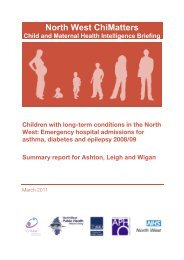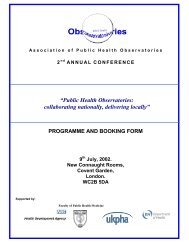9261 HEPATITIS C REPORT GALLEY - North West Public Health ...
9261 HEPATITIS C REPORT GALLEY - North West Public Health ...
9261 HEPATITIS C REPORT GALLEY - North West Public Health ...
Create successful ePaper yourself
Turn your PDF publications into a flip-book with our unique Google optimized e-Paper software.
ehaviour at some stage in their drug using career (although the rates of injecting<br />
among those attending SES and pharmacy SES are likely to be higher), giving a<br />
conservative estimate of 30,200 IDUs. However, statistical estimations of the hidden<br />
population of drug users in Merseyside (based on the overlap between the number of<br />
people contacting drugs agencies and those arrested by the police for drug crime)<br />
suggest that only about half of problematic heroin users are in contact with services<br />
(Hardi & Bellis 1999). Although this would suggest that there may be twice as many<br />
problematic drug users in the <strong>North</strong> <strong>West</strong> than we have estimated, the proportion of<br />
the hidden population of drug users who are injectors cannot be determined.<br />
In the <strong>North</strong> <strong>West</strong> of England, 67% of IDUs requesting a hepatitis test tested positive<br />
for hepatitis C (Lamden et al. 1998). Since the sample was drawn from those requesting<br />
a test, only a subset of the total population of IDUs was included. Little is known about<br />
potential differences in patterns of injecting and sharing between groups attending<br />
different agencies or none at all. A Scottish survey found little difference between<br />
prevalence of hepatitis C among IDUs recruited from SES, treatment centres and on the<br />
street (Taylor et al 2000). However, a survey of HIV prevalence among female IDUs in<br />
London found a higher prevalence in those recruited from the community than in those<br />
attending treatment agencies (Judd et al. 1999). Therefore, the assessment of the levels<br />
of hepatitis C in the wider drug using communities requires sampling individuals<br />
attending different services as well as those not in contact with services at all (Aim 1 of<br />
this study).<br />
Of the new agency episodes reported to the DMD, 73% were clients who reported<br />
having injected at some stage previously, and of those, 48% reported ever having<br />
shared injecting equipment (Birtles et al. 1999). A high proportion of those using drugs<br />
have periods of imprisonment, where continued drug use and levels of sharing are<br />
high (Eaton et al. 1998; section 1.3). However, estimations of sharing behaviour often<br />
rely on a single question on sharing behaviour that may not measure the extent of<br />
sharing (Hunter & Stimson 1998). In depth questions on sharing behaviour of IDUs in<br />
the <strong>North</strong> <strong>West</strong> revealed that around 80% of IDUs had shared injecting equipment in<br />
the previous four weeks (Speed & Bennet 1997). Moreover, there was a lack of<br />
knowledge among IDUs as to the risks of sharing injecting paraphernalia compared to<br />
the more well known risks of sharing needles and syringes (Speed & Bennett 1997).<br />
The number of people in contact with services who share injecting equipment in the<br />
<strong>North</strong> <strong>West</strong> can be estimated, assuming 80% of the estimated 30,200 IDUs share.<br />
This leads to the prediction that there are around 24,100 current drug users who have<br />
shared injecting equipment. Conservatively, this ignores those that have used drugs in<br />
the past but now abstain from drugs and do not use drugs services.<br />
12<br />
H EPATITIS C IN INJECTING DRUG USERS IN THE N ORTH W EST











